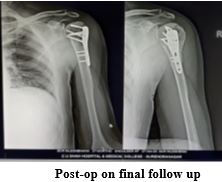A Clinical Study to Compare Functional Outcome of Proximal HumerusFracture in Adults (18- 80yrs) Treated By Philos Platting andConservative Modalities
Abstract
Introduction: It is the commonest fracture affecting the shoulder girdle in adults. Proximal humeralfractures account for almost 7% of all fractures and make up 80% of all humeral fractures. Thepurpose of this study is to carry out to enlighten functional outcome fracture proximal humerustreated with conservative and PHILOS platting and comparison of that. Material and
Method:Twenty-six patients attended the Department Of Orthopaedics from May 2018 to August 2020 andwere involved in this study prospectively, out of which 11 were male, and 15 were female. Theywere analysed clinically and radiologically using Constant and Murley shoulder scoring criteria. Outof 26 cases, 12 were treated conservatively, and 14 were treated by Pen reduction internal fixation(ORIF)
Result: Out of 12 patients treated conservatively, three had excellent, seven had good, and2 had fair functional outcome, whereas 14 patients treated by open reduction and internal fixationtwo had excellent, 4 had good, four had fair, and 4 had the poor functional outcome. Complicationswere seen in 9 patients. Out of that, five patients had shoulder stiffness, 3 had malunion, and 1 hadimpingement of implant.
Conclusion: Proximal humerus fracture occurred most commonly in the4th to 6th decade of life. For minimally displaced fracture, treatment of choice is nonoperative. For 2part fracture treated with conservative modalities showed slightly better results than operatedpatients, but for 3 part fracture operated patients had somewhat better results than conservative.
Downloads
References
2. Philipp N. Streubel, Joaquin Sanchez-Sotelo, and Scott P. Steinmann: Rockwood and Greens Fractures in Adults, 9th edition, section 2upper extremity, 35 proximal humerus fractures.
3. Bell MJ, Beauchamp CG, Kellam JK, et al. The results of plating humeral shaft fractures in patients with multiple injuries. The Sunnybrook experience. J Bone Joint Surg Br. 1985; 67(2):293–296.
4. R.H. Cofield (1988): Campbell’s operative orthopedics 13th edition volume three pg 2936
5. Neer CN. Displaced proximal humeral fractures.II. Treatment of three-part and four-part displacement. J Bone Joint Surg Am. 1970;52:1090-1103.
6. Jost B, Spross C, Grehn H, Gerber C. Locking plate fixation of fractures of the proximal humerus: analysis of complications, revision strategies and outcome. J Shoulder Elbow Surg. 2013;22:542-549.
7. Court-Brown CM, Garg A, McQueen MM. The epidemiology of proximal humeral fractures. Acta Orthop Scand. 2001;72:365-371.
8. Rajinder Singh Gaheer Fixation of 3and 4part Proximal Humerus Fractures Using the PHILOS Plate: Midterm Results Orthopedics ,September 2010 Volume 33 · Issue 9
9. Sameer Aggarwal,1 Kamal Bali, 1 Mandeep S Dhillon,1 Vishal Kumar,1 and Aditya K Mootha :Displaced proximal humeral fractures: an Indian experience with locking plates : J Orthop Surg Res. 2010; 5: 60. PMCID: PMC2933712
10. H. Resch, P. Povacz, R. Fr ¨Ohlich, M. Wambacher: Percutaneous Fixation Of Three And Four-part Fractures Of The Proximal Humerus, Journal Of Bone And Joint Surgery(Br) Vol. 79B, No. 2, March 1997
11. Yong Girl Rhee et al, Indirect Reduction Technique in Proximal Humeral Fractures Stabilized by Locking Plates, March 2014Clinics in Shoulder and Elbow 17(1)
12. Joseph D. Zuckerman ,James P. Ward :Disorder Of The Shoulder , Diagnosis and Management : Shoulder trauma ,3rd edition, Chapter No 2
: Nonoperative Management of Proximal Humerus Fractures: Indications, Protocols, and Outcomes
13. Canbora MK, Kose O, Polat A, Konukoglu L, Gorgec M. Relationship between the functional outcomes and radiological results of conservatively
treated displaced proximal humerus fractures in the elderly: A prospective study. Int J Shoulder Surg 2013;7:1059
14. Bjarne Kristiansen Gunner Barfed Jesper Bredesen Jes ErinMadsen Bjarne Grum: Epidemiology of proximal humeral fractures, Acta Orthop. Scand. 58, 7577, 1987

Copyright (c) 2022 Author (s). Published by Siddharth Health Research and Social Welfare Society

This work is licensed under a Creative Commons Attribution 4.0 International License.


 OAI - Open Archives Initiative
OAI - Open Archives Initiative


















 Therapoid
Therapoid

